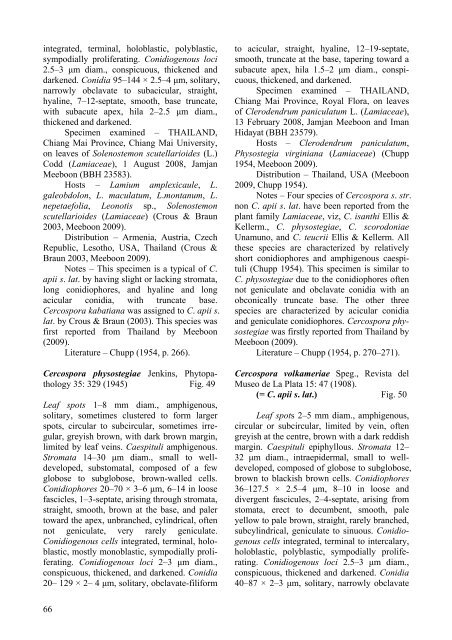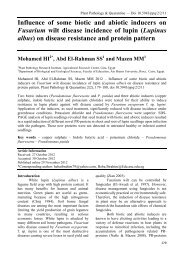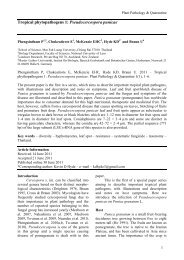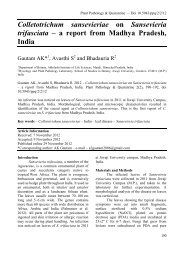Genus Cercospora in Thailand: Taxonomy and Phylogeny (with a ...
Genus Cercospora in Thailand: Taxonomy and Phylogeny (with a ...
Genus Cercospora in Thailand: Taxonomy and Phylogeny (with a ...
You also want an ePaper? Increase the reach of your titles
YUMPU automatically turns print PDFs into web optimized ePapers that Google loves.
<strong>in</strong>tegrated, term<strong>in</strong>al, holoblastic, polyblastic,<br />
sympodially proliferat<strong>in</strong>g. Conidiogenous loci<br />
2.5–3 μm diam., conspicuous, thickened <strong>and</strong><br />
darkened. Conidia 95–144 × 2.5–4 μm, solitary,<br />
narrowly obclavate to subacicular, straight,<br />
hyal<strong>in</strong>e, 7–12-septate, smooth, base truncate,<br />
<strong>with</strong> subacute apex, hila 2–2.5 μm diam.,<br />
thickened <strong>and</strong> darkened.<br />
Specimen exam<strong>in</strong>ed – THAILAND,<br />
Chiang Mai Prov<strong>in</strong>ce, Chiang Mai University,<br />
on leaves of Solenostemon scutellarioides (L.)<br />
Codd (Lamiaceae), 1 August 2008, Jamjan<br />
Meeboon (BBH 23583).<br />
Hosts – Lamium amplexicaule, L.<br />
galeobdolon, L. maculatum, L.montanum, L.<br />
nepetaefolia, Leonotis sp., Solenostemon<br />
scutellarioides (Lamiaceae) (Crous & Braun<br />
2003, Meeboon 2009).<br />
Distribution – Armenia, Austria, Czech<br />
Republic, Lesotho, USA, <strong>Thail<strong>and</strong></strong> (Crous &<br />
Braun 2003, Meeboon 2009).<br />
Notes – This specimen is a typical of C.<br />
apii s. lat. by hav<strong>in</strong>g slight or lack<strong>in</strong>g stromata,<br />
long conidiophores, <strong>and</strong> hyal<strong>in</strong>e <strong>and</strong> long<br />
acicular conidia, <strong>with</strong> truncate base.<br />
<strong>Cercospora</strong> kabatiana was assigned to C. apii s.<br />
lat. by Crous & Braun (2003). This species was<br />
first reported from <strong>Thail<strong>and</strong></strong> by Meeboon<br />
(2009).<br />
Literature – Chupp (1954, p. 266).<br />
<strong>Cercospora</strong> physostegiae Jenk<strong>in</strong>s, Phytopathology<br />
35: 329 (1945) Fig. 49<br />
Leaf spots 1–8 mm diam., amphigenous,<br />
solitary, sometimes clustered to form larger<br />
spots, circular to subcircular, sometimes irregular,<br />
greyish brown, <strong>with</strong> dark brown marg<strong>in</strong>,<br />
limited by leaf ve<strong>in</strong>s. Caespituli amphigenous.<br />
Stromata 14–30 μm diam., small to welldeveloped,<br />
substomatal, composed of a few<br />
globose to subglobose, brown-walled cells.<br />
Conidiophores 20–70 × 3–6 μm, 6–14 <strong>in</strong> loose<br />
fascicles, 1–3-septate, aris<strong>in</strong>g through stromata,<br />
straight, smooth, brown at the base, <strong>and</strong> paler<br />
toward the apex, unbranched, cyl<strong>in</strong>drical, often<br />
not geniculate, very rarely geniculate.<br />
Conidiogenous cells <strong>in</strong>tegrated, term<strong>in</strong>al, holoblastic,<br />
mostly monoblastic, sympodially proliferat<strong>in</strong>g.<br />
Conidiogenous loci 2–3 μm diam.,<br />
conspicuous, thickened, <strong>and</strong> darkened. Conidia<br />
20– 129 × 2– 4 μm, solitary, obclavate-filiform<br />
66<br />
to acicular, straight, hyal<strong>in</strong>e, 12–19-septate,<br />
smooth, truncate at the base, taper<strong>in</strong>g toward a<br />
subacute apex, hila 1.5–2 μm diam., conspicuous,<br />
thickened, <strong>and</strong> darkened.<br />
Specimen exam<strong>in</strong>ed – THAILAND,<br />
Chiang Mai Prov<strong>in</strong>ce, Royal Flora, on leaves<br />
of Clerodendrum paniculatum L. (Lamiaceae),<br />
13 February 2008, Jamjan Meeboon <strong>and</strong> Iman<br />
Hidayat (BBH 23579).<br />
Hosts – Clerodendrum paniculatum,<br />
Physostegia virg<strong>in</strong>iana (Lamiaceae) (Chupp<br />
1954, Meeboon 2009).<br />
Distribution – <strong>Thail<strong>and</strong></strong>, USA (Meeboon<br />
2009, Chupp 1954).<br />
Notes – Four species of <strong>Cercospora</strong> s. str.<br />
non C. apii s. lat. have been reported from the<br />
plant family Lamiaceae, viz, C. isanthi Ellis &<br />
Kellerm., C. physostegiae, C. scorodoniae<br />
Unamuno, <strong>and</strong> C. teucrii Ellis & Kellerm. All<br />
these species are characterized by relatively<br />
short conidiophores <strong>and</strong> amphigenous caespituli<br />
(Chupp 1954). This specimen is similar to<br />
C. physostegiae due to the conidiophores often<br />
not geniculate <strong>and</strong> obclavate conidia <strong>with</strong> an<br />
obconically truncate base. The other three<br />
species are characterized by acicular conidia<br />
<strong>and</strong> geniculate conidiophores. <strong>Cercospora</strong> physostegiae<br />
was firstly reported from <strong>Thail<strong>and</strong></strong> by<br />
Meeboon (2009).<br />
Literature – Chupp (1954, p. 270–271).<br />
<strong>Cercospora</strong> volkameriae Speg., Revista del<br />
Museo de La Plata 15: 47 (1908).<br />
(= C. apii s. lat.) Fig. 50<br />
Leaf spots 2–5 mm diam., amphigenous,<br />
circular or subcircular, limited by ve<strong>in</strong>, often<br />
greyish at the centre, brown <strong>with</strong> a dark reddish<br />
marg<strong>in</strong>. Caespituli epiphyllous. Stromata 12–<br />
32 μm diam., <strong>in</strong>traepidermal, small to welldeveloped,<br />
composed of globose to subglobose,<br />
brown to blackish brown cells. Conidiophores<br />
36–127.5 × 2.5–4 μm, 8–10 <strong>in</strong> loose <strong>and</strong><br />
divergent fascicules, 2–4-septate, aris<strong>in</strong>g from<br />
stomata, erect to decumbent, smooth, pale<br />
yellow to pale brown, straight, rarely branched,<br />
subcyl<strong>in</strong>drical, geniculate to s<strong>in</strong>uous. Conidiogenous<br />
cells <strong>in</strong>tegrated, term<strong>in</strong>al to <strong>in</strong>tercalary,<br />
holoblastic, polyblastic, sympodially proliferat<strong>in</strong>g.<br />
Conidiogenous loci 2.5–3 μm diam.,<br />
conspicuous, thickened <strong>and</strong> darkened. Conidia<br />
40–87 × 2–3 μm, solitary, narrowly obclavate









